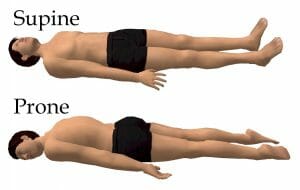Prone Position Definition
The prone position is an anatomical term used to describe an organism with its ventral side against the ground. For a human and similar animals, this means laying on their stomach. It also means that the limbs are not extended, and that the organism is not standing or sitting. This can be seen in the following image. In the image, you can also see the supine position, which is similar to prone, except that the organism is on its back or dorsal side.
Uses of Prone Position
The prone position has many uses across different industries. In the medical field, the position is used to preform many different procedures. Amongst these are surgeries to the back, therapeutic massage, and various biopsies spots for different tissues. This position gives access to many tissues, including the spine, kidneys, lungs, muscles, and many others. Still other professionals will have their patients lie prone for therapies like acupuncture, various allergy tests, and a wide variety of other reasons.
However, it is not only the medical field which employs the prone position. It is also used widely in various exercise programs, as a starting point and resting position. Yoga, for instance, uses it before going to various poses which stretch and strengthen the back. Other types of stretching and muscle building also require the use of the position. The military, police force, and shooting sports enthusiasts use the prone position to create stability and increase their accuracy. The increased number of contact points with the body and the ground increase the stability of a shooter.
Lastly, behavioral scientists can observe animals in the prone position and draw different conclusions about their behavior and health. Not all animals use the prone position in the same way. A cat in the prone position could either mean it is stalking prey, or relaxing. The position of the legs determine which of these is true. A stalking cat in the prone position will still have its legs tucked under it, ready to pounce. Some animals never use the prone position, and indications of their health can be quickly made if seen in this position. A bat, for instance, would never find itself in the prone position unless it has fallen to the ground. This would indicate that the bat underwent trauma, is sick, or is debilitated in some other way.
References
- De luliis, G., & Pulera, D. (2007). The Dissection of Vertebrates. Amsterdam: Academic Press.
- Nakos, G., Batistatou, A., Galiatsou, E., Konstanti, E., Koulouras, V., Kanavarous, P., . . . Bai, M. (2006). Lung and ‘end organ’ injury due to mechanical ventilation in animals: comparison between the prone and supine positions. Critical Care, 10(1), R38.
Prone Position

No comments:
Post a Comment